The finalists for this year’s Calder Trophy were announced on Saturday and, like most NHL Awards announcements, were not without their share of controversy. While most NHL pundits feel Elias Pettersson could have had the trophy engraved in January, the other two finalists have been met with questions.
St. Louis Blues goaltender Jordan Binnington had a very solid rookie season. Starting 30 games, he earned a 24-5-0-1 record to go along with a solid .927 save percentage and a glistening 1.89 goals-against average.
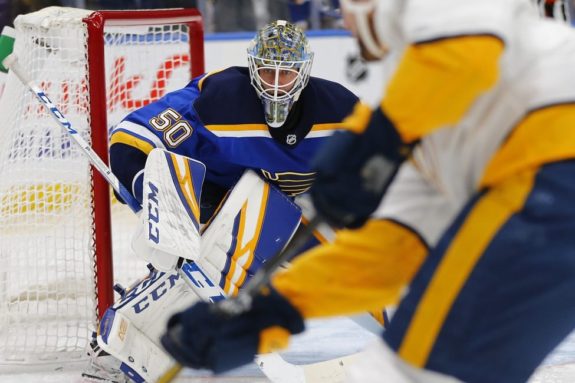
Looking under the hood into his underlying numbers, Binnington was not just the beneficiary of having a solid defensive team in front of him. According to Sean Tierney’s work, on average, Binnington faced 2.050 expected goals per game based on the quality of shots he faced. He allowed only 1.844 goals per game. This translates to allowing five and half fewer goals than expected over the course of his season. He was able to hold his own and push the Blues from last in the league as the calendar turned to 2019 to the second round of the playoffs.
The main controversy regarding Binnington comes with his age. As a 25-year-old, he is a half decade older than the other nominees. Some feel this should make him disqualified from Calder Trophy consideration, although the precedent of a player in his mid-20s winning the Calder Trophy was recently set with Artemi Panarin. Others feel that appearing in only 32 games is too small a sample size.
What can’t be denied, however, is his impact on the Blues’ season. His ability to shut the door in net propelled the team up the standings and has given them a berth in the Western Conference Semi Finals.
The Third Calder Candidate
Binnington’s story aside, the major contention among NHL fans comes with the third nominee. Rasmus Dahlin was named a finalist for the Calder Trophy by the Professional Hockey Writers Association. A large portion of fans feel very strongly that Dallas Stars defenceman Miro Heiskanen is the more deserving recipient of Calder recognition. Who should the third nominee be- Dahlin or Heiskanen?
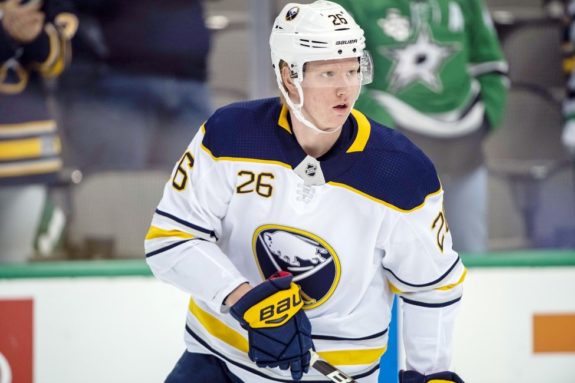
Comparing their stats side-by-side, both young defencemen had excellent rookie campaigns. Heiskanen played in all 82 games, skated over 23 minutes each game and collected 33 points, including 12 goals. Dahlin also played 82 games, averaged over 21 minutes per game and recorded 44 points with 20 on the power play.
Looking into their deeper numbers presented by Evolving Hockey, both Heiskanen and Dahlin are able to solidly contribute to driving offence and getting the puck out of their end. Heiskanen shows greater strengths in his expected goals when starting in the offensive zone and his shot share when starting in the defensive zone. Dahlin’s advantages are in his shot share starting in the offensive zone and his expected goals from the defensive zone.
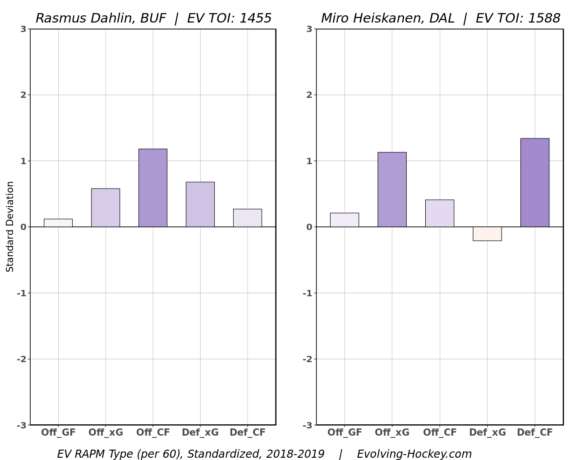
A major difference comes with each player’s contribution to their teams’ power play. Heiskanen struggled during his rookie season with the man advantage, proving to be mostly a liability and allowing more expected goals than he contributed. Dahlin proved to be an absolute stud on the power play, showing signs of being the elite offensive defenceman he was always touted to be.
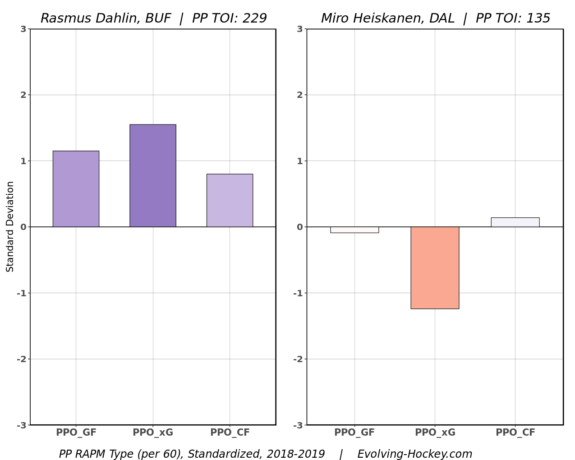
What’s even more remarkable is how Dahlin’s work on the power play this season compares to perennial Norris candidate Victor Hedman. While Hedman boasted very strong goals for, Dahlin was superior in his shot share and far exceeded Hedman’s expected goals. Let’s keep in mind that Dahlin was not even the legal drinking age in most of Canada for his entire campaign and played for a Sabres team that finished in the bottom half of the league in terms of power play proficiency.
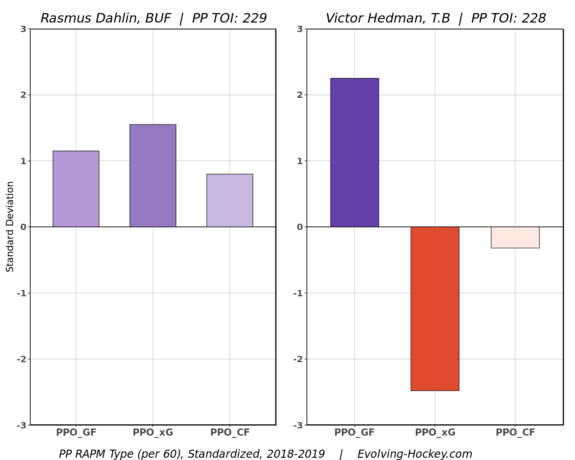
Rookies Carrying the Veterans
Heiskanen’s incredible regular season can be seen in his impact on his most common linemates. Up front, Heiskanen’s most common linemate this season according to Natural Stat Trick was Tyler Seguin. For Seguin, when he played without Heiskanen, he controlled 48.92 percent of all shots. Playing with Heiskanen, the number jumped to 52.18 percent.
Heiskanen’s main defensive partner this season was the oft-maligned Roman Polak. Polak struggled to control the offence on a regular basis and without Heiskanen owned 45.50 percent of the scoring chances at even strength. When paired with Heiskanen, the number rose to 46.33 percent. While that’s not a monumental leap, the 19-year-old rookie was able to support the 13-year veteran night in and night out.
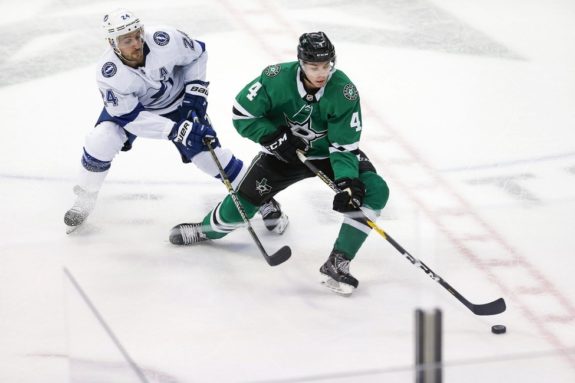
Across the board, Heiskanen’s rookie season could have been much more impressive had he been deployed with almost anyone besides Polak. Without Polak, Heiskanen saw increases in his Corsi, Fenwick, shots, goals-for percentage, expected-goals-for percentage, scoring-chances-for percentage, high-danger-chances-for percentage and high-danger-goals-for percentage.
Looking ahead, Heiskanen is poised to be a dominant force from the Dallas back-end for years to come. He has proven himself to be a rock-solid contributor in both his own end and the offensive zone. Starting as early as next season, with the right deployment, Heiskanen can put himself in a position to be a regular Norris candidate.
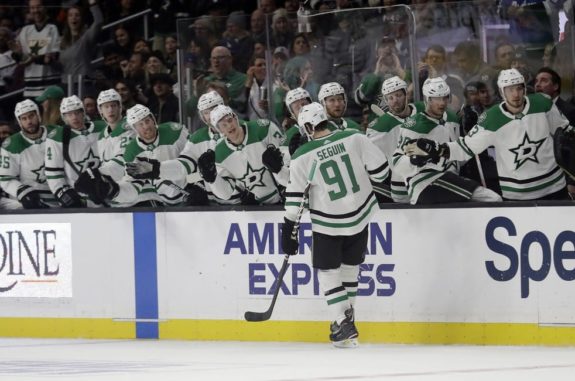
Dahlin similarly spent most of his rookie season playing with inferior teammates. He spent 554:54 dragging Zach Bogosian around the ice. Like Heiskanen with Polak, Dahlin improved the veteran Bogosian’s numbers in every statistical category.
Where Dahlin’s season differed from Heiskanen is in the depth of quality of teammates. Although spending the majority of his season with Polak, Heiskanen had the pleasure of skating 343:39 with John Klingberg. Klingberg, a world-class defenceman in his own right, was able to dominate when paired with Heiskanen. That duo will no doubt terrorize opponents from the back-end for the next decade.
Dahlin, on the other hand, was not as fortunate. His second most common partner was the “lesser Rasmus”- Rasmus Ristolainen. Like Polak, Ristolainen saw increases in every major statistical category when playing with Dahlin. A trio of categories experienced eye-popping increases. Without Dahlin, Ristolainen owned a 39.62 percent share of goals scored while he was on the ice. With Dahlin, that number jumped over seven percent to 47.37 percent.
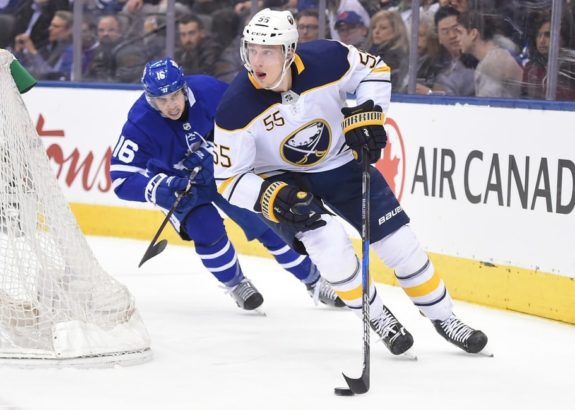
On his own, Ristolainen held a 37.78% share of goals scored off of scoring chances. When Dahlin was on the ice, there was an increase of nearly 10 percent to 47.06. In terms of high-danger goals, Ristolainen possessed a 41.82 percent share without Dahlin. With Dahlin, the number rose over eight percent to 50.00.
Why Dahlin Deserves the Nod
Indeed, both Dahlin and Heiskanen had impressive showings in their rookie seasons. The duo demonstrated massive offensive potential while at the same time not bleeding chances against. As teenagers, both were able to solidify and even raise the games of veteran teammates. Finally, the two phenoms played heavy minutes and successfully limited the offence of opposing teams’ top players.
What sets Dahlin apart in terms of Calder voting is his offensive output. His season found him finishing with the second-most points ever by an 18-year-old defenseman. He finished ahead of the likes of Brent Burns, Aaron Ekblad, and some guy named Bobby Orr. All the while, he did this playing on an inferior team with more challenging deployment than Heiskanen. While both had excellent rookie campaigns, the nomination deservedly went to Dahlin.
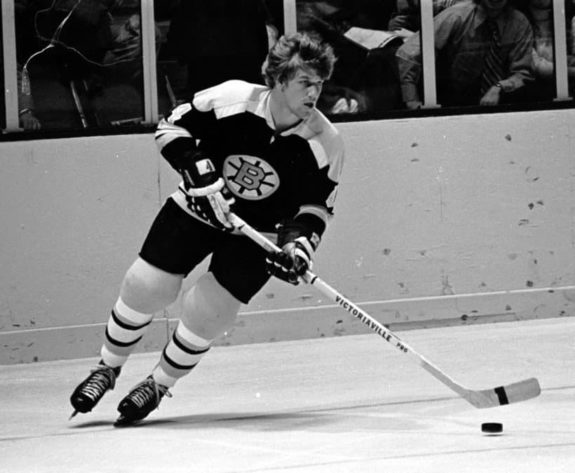
With all due respect to Pettersson, a strong argument could be made that Dahlin should in fact win this year’s Calder Trophy. Without a doubt, Pettersson had an electrifying season. It will go down as one of the all-time greatest rookie seasons. What Dahlin accomplished given the context of history, the difficulty of playing defense in the NHL and the difficulty of playing defense in Buffalo especially, the concept of Dahlin winning should not be immediately dismissed.
There could be an argument made that Heiskanen should have been nominated ahead of Binnington. While Binnington had a superb rookie season, he appeared in 50 fewer games than Heiskanen. Couple that with their age difference of six years and you have a compelling case.
This will not be the last time that Dahlin and Heiskanen will be compared. The Calder nomination is only the beginning. For the next 15 years you can expect these two to trade Norris Trophies back and forth across the continent. That’s good news for fans of the Sabres, Stars, and the NHL. What’s required of us is to buckle up and enjoy the high-octane hockey these two phenoms have in store for us.